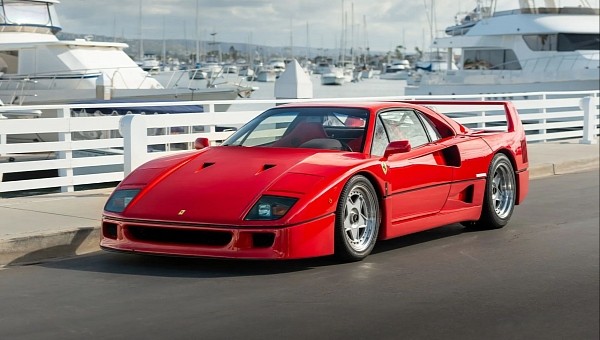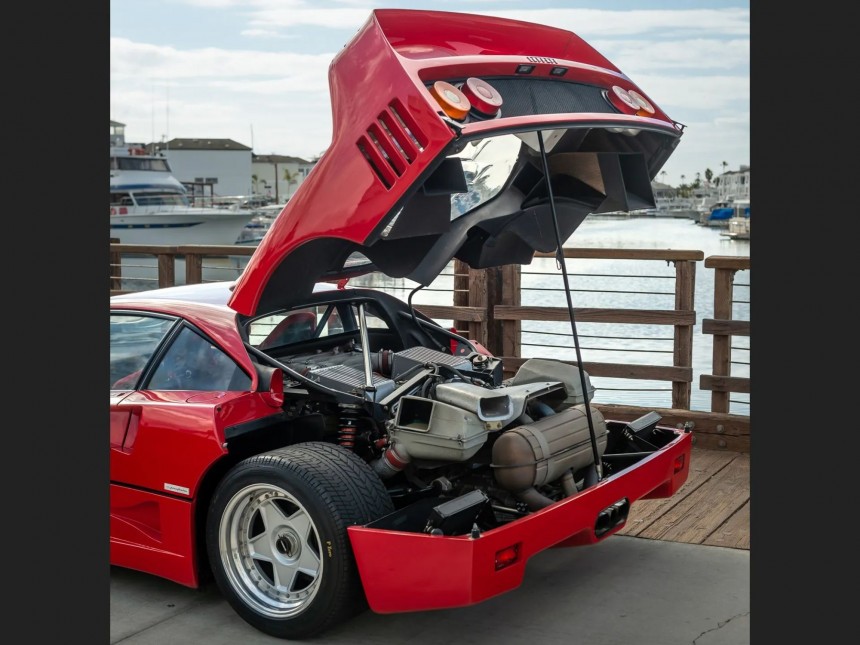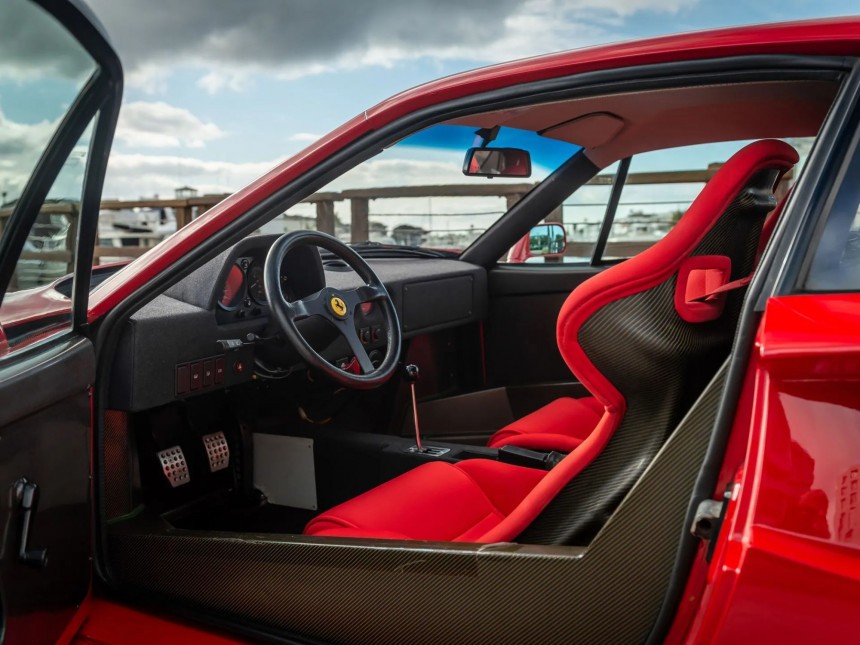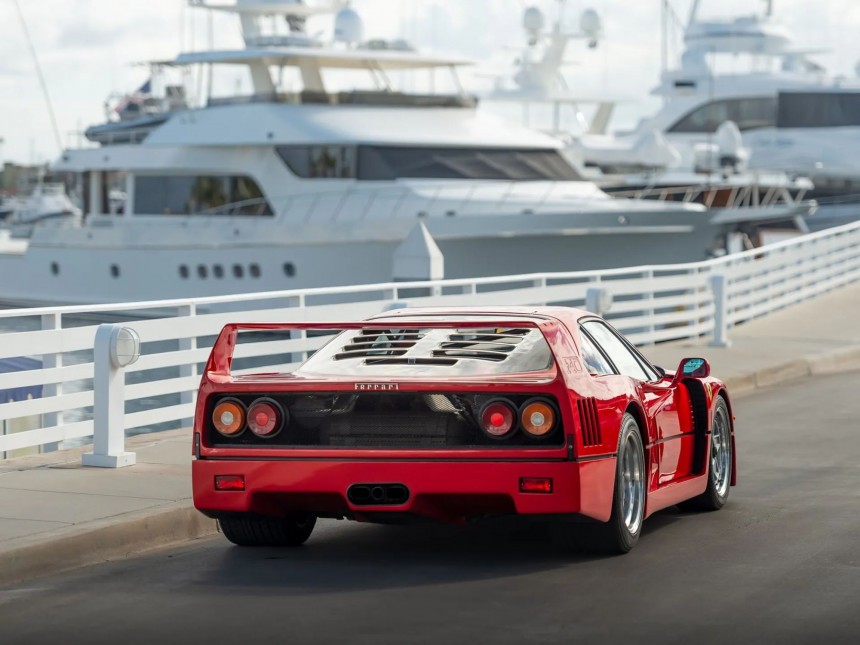If you ask a car enthusiast what the most iconic Ferrari is, chances are “the Ferrari F40” might be their answer. This supercar was created to celebrate the 40th anniversary of the 125 S, Maranello’s first model. Its initial purpose was to compete in the FIA Group B, and it was developed from the 288 GTO and modeled after the Porsche 959.
After the racing class was canceled, the project was at risk of being scrapped. Instead, Ferrari used the five initial 288 GTO Evoluzione as the basis of a new 40th-anniversary road car. This vehicle is extra special as it was the last supercar devised under Enzo Ferrari’s stewardship.
The F40’s structure, components, and appearance all reflected its competition purposes. The F40 boasted a race-developed steel tube-frame chassis with four-wheel double-wishbone independent suspension. Other elements that hinted toward its racing capabilities were the coil-over Koni shock absorbers and four-caliper ventilated disc brakes.
Pietro Camardella created the coachwork under the direction of Leonardo Fioravanti - its aerodynamic design was optimized in Pininfarina’s wind tunnel. Ferrari opted for paneling woven from Kevlar and carbon fiber; their approach has two significant advantages: curb weight was reduced by about 20%, and the F40’s structural rigidity was tripled.
The appropriate amount of power was also fitted to the car – the 288’s twin-turbocharged V8 was bored to displace 2.9 liters. Behr intercoolers and IHI turbochargers were also added. The engine was connected to a five-speed transaxle, actuated by a gated shifter.
All these modifications added up to give the vehicle impressive performance – the engine outputted 478 hp (356 kW or 485 ps) and 576.2 Nm (425 lb-ft) of torque. It took the F40 only 3.8 seconds to reach 60 mph (97 kph), and it maxed out at a top speed of 201 mph.
The car’s interior continued to reflect what the machine was born for. It featured plastic-composite racing seats with cloth upholstery, Perspex windows, drilled pedals, and pull-strap door releases.
Ferrari initially planned to produce only 400 units of the vehicle. After unveiling it at the 1987 Frankfurt Motor Show, its popularity quickly grew. Ferrari ultimately built 1,315 cars, which were initially only available in Europe. They also didn’t feature an adjustable suspension or catalytic converters. That was until 1990, when Ferrari started delivering a version with catalytic converters.
As most would expect, collectors jumped to purchase the machine. But to preserve its value and avoid any incidents, most of them limited the F40 to concours exhibition and showroom viewing. A handful of fortunate individuals got to experience the car at its true potential.
For instance, five-time Le Mans champion Derek Bell pushed the car’s limits during a test drive for Classic & Sports Car magazine conducted in the mid-2000s. This is what he said about it: “It’s just magnificent…This is a car to make your hair curl. The power delivery is sensational, and I love the way the turbos come on with such a rush. Very quickly the situation changes from neutral understeer to amazing oversteer, but it’s all superbly predictable.”
The model set to be auctioned is a rare find. According to the research of a marque expert, the production of the F40 with chassis number 94277 started in May 1992. It had a European spec, complete with a catalytic converter. It was finished in the standard Rosso Corsa paint, and its interior was fitted with cloth Vigogna upholstery.
The vehicle ended up in an enthusiast’s hands in Moers, Germany, in September 1992. It remained in Germany until it was exported to Japan in April 1997 – a Japanese export certificate on file supports this claim.
The Ferrari was well-maintained from September 2012 to November 2020, and just 2,009 km (1,248 miles) were added to the odometer. It was also equipped with new engine mounts, a starter motor, a fuel pump, and an ignition. Restorations went even deeper than that – in 2018, the fuel tanks were disassembled and cleaned, and the tank sponges were replaced. More importantly, its timing belt was replaced.
The consignor imported the F40 to the U.S. in December 2022, and it was gifted with a comprehensive service from Ferrari of Newport Beach, California. It’s accompanied by an owner’s manual, a tool roll, and several documents that attest to its history and modifications, such as the Massini report, export paperwork, and Japanese service invoices.
This is as close as you can get to a genuine F40 experience. The example boasts a striking exterior, and the maintenance work throughout the years managed to preserve the mechanical elements. Its odometer currently reads 19,967 km (about 12,239 miles).
The auction listing states the vehicle will be offered on Thursday, January 26, 2023. A $2.2M to $2.8M price is suggested. It won’t come as a surprise if the future owner ends up having to spend even more than the recommended price for this splendid and unique 1992 F40. Whatever the cost, most car enthusiasts would probably be more than happy to add it to their collection.
The F40’s structure, components, and appearance all reflected its competition purposes. The F40 boasted a race-developed steel tube-frame chassis with four-wheel double-wishbone independent suspension. Other elements that hinted toward its racing capabilities were the coil-over Koni shock absorbers and four-caliper ventilated disc brakes.
Pietro Camardella created the coachwork under the direction of Leonardo Fioravanti - its aerodynamic design was optimized in Pininfarina’s wind tunnel. Ferrari opted for paneling woven from Kevlar and carbon fiber; their approach has two significant advantages: curb weight was reduced by about 20%, and the F40’s structural rigidity was tripled.
The appropriate amount of power was also fitted to the car – the 288’s twin-turbocharged V8 was bored to displace 2.9 liters. Behr intercoolers and IHI turbochargers were also added. The engine was connected to a five-speed transaxle, actuated by a gated shifter.
The car’s interior continued to reflect what the machine was born for. It featured plastic-composite racing seats with cloth upholstery, Perspex windows, drilled pedals, and pull-strap door releases.
Ferrari initially planned to produce only 400 units of the vehicle. After unveiling it at the 1987 Frankfurt Motor Show, its popularity quickly grew. Ferrari ultimately built 1,315 cars, which were initially only available in Europe. They also didn’t feature an adjustable suspension or catalytic converters. That was until 1990, when Ferrari started delivering a version with catalytic converters.
As most would expect, collectors jumped to purchase the machine. But to preserve its value and avoid any incidents, most of them limited the F40 to concours exhibition and showroom viewing. A handful of fortunate individuals got to experience the car at its true potential.
The model set to be auctioned is a rare find. According to the research of a marque expert, the production of the F40 with chassis number 94277 started in May 1992. It had a European spec, complete with a catalytic converter. It was finished in the standard Rosso Corsa paint, and its interior was fitted with cloth Vigogna upholstery.
The vehicle ended up in an enthusiast’s hands in Moers, Germany, in September 1992. It remained in Germany until it was exported to Japan in April 1997 – a Japanese export certificate on file supports this claim.
The Ferrari was well-maintained from September 2012 to November 2020, and just 2,009 km (1,248 miles) were added to the odometer. It was also equipped with new engine mounts, a starter motor, a fuel pump, and an ignition. Restorations went even deeper than that – in 2018, the fuel tanks were disassembled and cleaned, and the tank sponges were replaced. More importantly, its timing belt was replaced.
This is as close as you can get to a genuine F40 experience. The example boasts a striking exterior, and the maintenance work throughout the years managed to preserve the mechanical elements. Its odometer currently reads 19,967 km (about 12,239 miles).
The auction listing states the vehicle will be offered on Thursday, January 26, 2023. A $2.2M to $2.8M price is suggested. It won’t come as a surprise if the future owner ends up having to spend even more than the recommended price for this splendid and unique 1992 F40. Whatever the cost, most car enthusiasts would probably be more than happy to add it to their collection.




















































